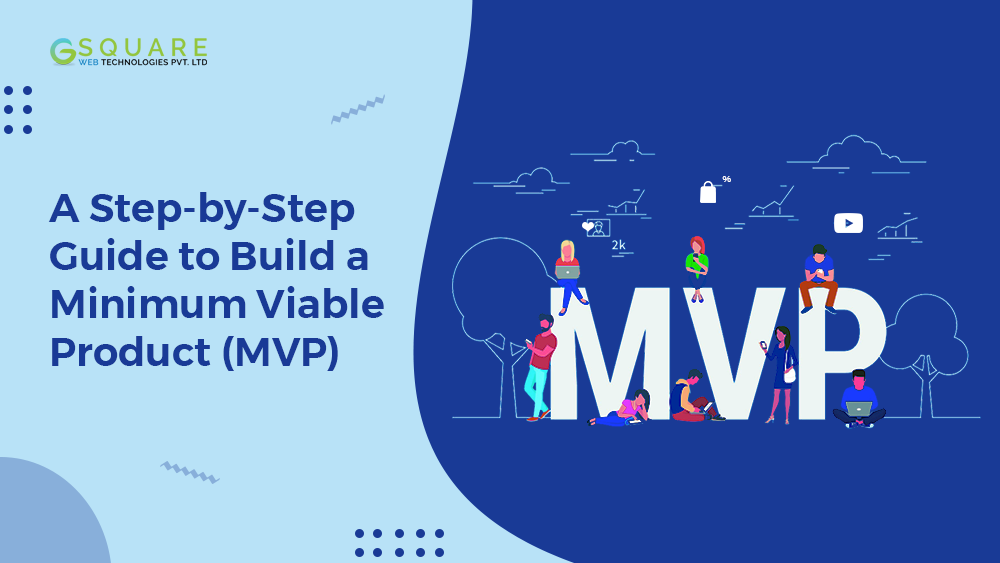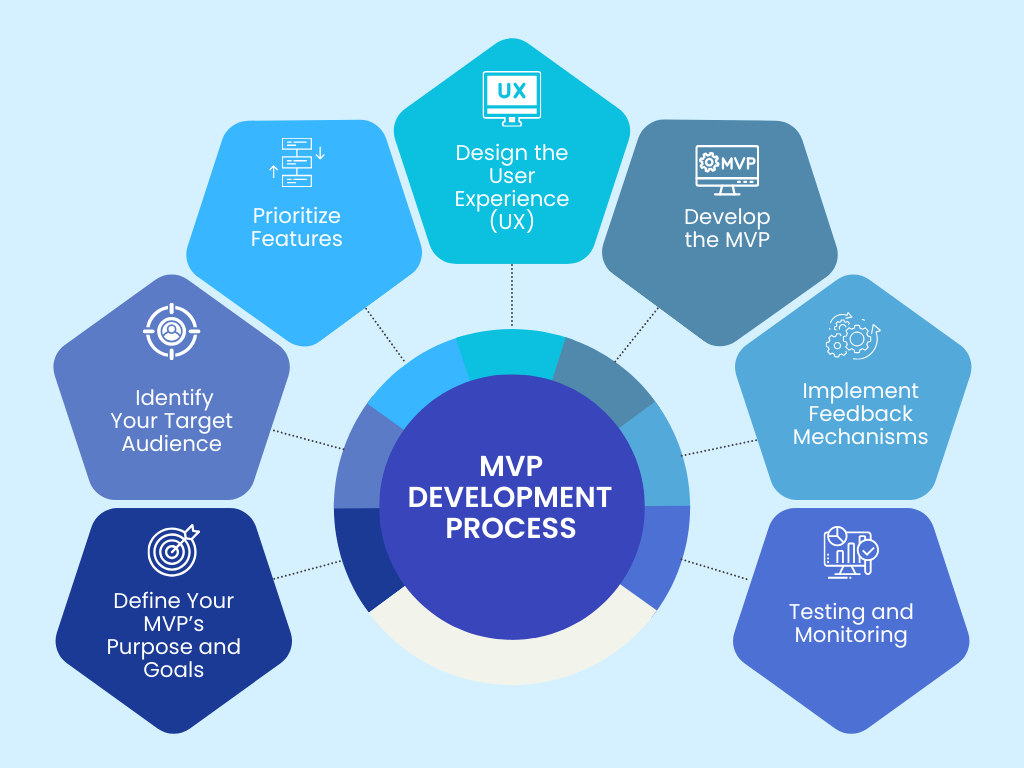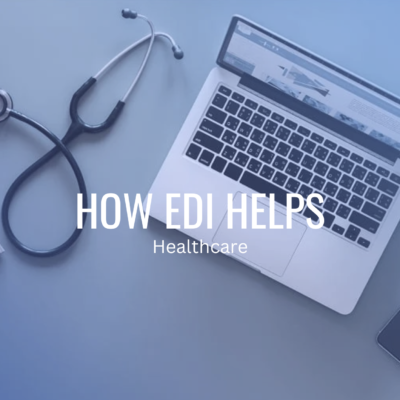
A Step-by-Step Guide to Build a Minimum Viable Product (MVP)
The development of a project is a time-consuming process and requires a lot of resources and effort. Usually, a full-scale product takes from 12 to 16 months to complete. Along with this much time, development also requires a lot of expensive resources including money, and effort in constant research, and testing.
To save time and ensure that the product that is under development will be successful, businesses use the MVP approach, which stands for Minimum Viable Product. It is an early stage of product development, launched in the middle of the development process and at its minimum usable form. In this piece of writing, we are going to learn about MVP, the process of its development, and its benefits, and will discuss other related topics. So without wasting any time let’s get started.
What is the Minimum Viable Product?
In simple terms, A Minimum Viable Product (MVP) is a type of foundational concept in product development. It is a simplified version of a product or service with minimum but enough features to satisfy early users. It helps in gathering valuable feedback that can help in the further development process. MVP is developed and provided to test the key hypotheses and validate assumptions. Since it uses the minimum resources, it is less time-consuming and more cost-effective.
Moreover, MVP comprises the essential features to address the core problem or need of the target audience. It does not come with unnecessary complexities but only with basic features that focus on the functionality that allows users to experience the product’s value proposition. Once launched businesses become capable of gathering user feedback that helps them in making informed decisions further helping in finalizing the direction of the product development. It prioritizes the improvements and enhancements based on real-world usage.
Purpose & Importance of MVP in Product Development
However, there are several objectives that can be accomplished using the MVP approach but some of the significant ones are as below:
- Validate Assumptions
When a full-scale product starts to be developed, business owners are not sure whether it will meet the needs of the consumers or not, so they start creating the product on the basis of assumptions. An MVP, at the minimum cost possible, can help validate these assumptions about user needs, preferences, and market demands. If these assumptions are not accurate, the development process can be adjusted in the required direction.
- Reduce Risk
As we have seen earlier, MVP minimizes the investment which lowers the financial risks associated with developing a full-scale product. Since it may take thousands, if not millions, dollars to complete a product, launching it initially for testing, may reduce financial risks and provide businesses with opportunities to invest that money in other essential operations or the development of other products.
- Accelerate Time-to-Market
When you go with MVP, it helps you gain a competitive edge in the market. As a first come first gain rule, is more or less, applicable in every market. You have to be a fast mover to get most of the benefits and leverage the demand hike in the market. So, MVP lets you fetch those initial opportunities in the market.
- Attract Early Adopters
Early adopters are the most loyal portion of your target audience. When you provide them with MVP, it appeals to them and they also love to give a try to your product and provide feedback on your new offerings. They are not only your well-wishers but also find themselves a part of the development process. This bond never breaks and you get the initial loyal users for your product, which is the most essential part of your product’s success.
- Generate Buzz
Just like the trailer of a movie, MVP is a trailer of your full-scale product that is currently under development. Just like movies your products can also create a buzz among your target audience. So, the MVP should be developed with all the core features that can attract users. This is something that lays the foundation for your long-term marketing efforts.
Things to Keep in Mind Before Start the Process
There are several things that should be kept in mind while starting the MVP (Minimum Viable Product) process, essentials of them are as below:
1. Clear Objectives:
First of all, define clear objectives and goals for your MVP. That means you must find out what problems you want to solve with that product. This should be clear along with the assumptions that you want to validate by releasing your products in the initial stage. Once done you can proceed further.
2. User-Centric Approach:
Remember, your product is for users, prioritize their needs, and keep revenue generation and other things in the second position in the hierarchy of your priority graph. You must focus on user needs and pain points. For this, you also have to understand your target audience and ensure that the MVP, you are going to develop and release, addresses their most pressing problems.
3. Minimalism:
You should keep the MVP minimal. That means you should focus only on essential features. In other words, only deliver the features that are necessary and related to the core values of the product. Do not try to implement plenty of links around upcoming features or something promotional in your MVP rather keep it simple in design and only focus on the features that are related to the core values and allow users to initially use the product seamlessly.
4. Rapid Development:
You should take minimum time to develop the MVP of a product. It should be developed rapidly and possibly in one-fourth of the total time to be consumed in full-scale product development. Quicker development means faster it gets into the hands of users. This ultimately leads to speeding up the process of gathering feedback. When everything gets done rapidly, it saves a lot of time and resources for the business that can be used in the implementation of other fruitful ideas.
5. Measurable Metrics:
You should define key performance indicators (KPIs) or metrics before initiating the development process. You can use them for evaluating the MVP’s success. Just like other businesses leverage it to evaluate their success, KPIs are also essential for evaluating the success of MVPs. Once you have done with this stuff, proceed further to develop a feedback mechanism.
6. Feedback Mechanisms:
We continually emphasize that MVP is Implemented solely to collect user feedback, so we can leverage that to develop our product in a more efficient way. To establish this objective we must provide an easy-to-navigate and accessible feedback mechanism in the MVP project. This mechanism can be embedded in the form of a feedback section or provide a link for the direct communication channels.
7. Iterative Mindset:
Keep the iterative mindset throughout the whole process as you have to repeat the almost same process again and again. Keep in mind that the MVP is just the beginning and you have to continue to improve the product based on user feedback and data, repeatedly. Sometimes this data might be not clear and you might need to keep it up with assumptions to get the best results possible and ensure the success of the final product.
8. Quality Matters:
Sometimes we assume that MVP is just a testing tool, but actually, it is the first impression of your potential final product. While keeping it minimal do everything possible to ensure that the MVP is of high quality. An MVP’s messy design or lack of basic features can turn users away and they may reject it at a very first impression. This may lead your product to be a failure.
9. Market Research:
Not only for the final product but also for MVP, conduct market research and put efforts into understanding your competitors and market dynamics. This is essential to help you position your MVP effectively. This also enables you to find accurate feedback that you can leverage to design the final product.
How to Develop an MVP – Step-by-Step Guide
After getting familiar with the basics, let’s learn how to develop an MVP, through this step by step as below:

Step 1: Define Your MVP’s Purpose and Goals
You can start building MVP by keeping the pain points it must address. For that purpose, you can establish a set of goals that are known as SMART stands for Specific, Measurable, Achievable, Relevant, and Time-bound. These goals can help in ensuring clarity and measurability. Once effectively done, you are ready to proceed further.
Step 2: Identify Your Target Audience
Now the next task is to create detailed user personas that include demographics, behaviors, and preferences. Once done you can target the audience more efficiently. For this purpose, you can utilize tools like Google Analytics. You also can perform surveys or arrange customer interviews. It will help you in gathering data about your target audience and ensure the success of the product.
Step 3:Prioritize Features
Not all the features are equally important, so you should prioritize them using techniques like MoSCoW stands for Must have, Should have, Could have, and Won’t have. As far as MVP is concerned, you should only focus on the essential features that directly address the core problem and provide value to users. Feature prioritizing is counted as the most essential stage of MVP development.
Step 4: Design the User Experience (UX)
Once the development process is started you can initiate developing wireframes or interactive prototypes. For this purpose, you can use design tools like Sketch, Figma, or Adobe XD. However, your preference is personal and you can choose the one you are comfortable with. Also ensure the MVP, you are designing, does follow best practices for usability, accessibility, and responsive design. If not do the required changes.
Step 5: Develop the MVP
Now the prime work starts from here, to start the development process first of all, select a technology stack that aligns with your project’s requirements, development speed, and scalability. You can consider frameworks and libraries that you are fluent with to accelerate the development. We recommend to choose from React for the front end or Django for the back end as they work best in MVP development, still, the choice is personal.
Despite that, it is suggested to keep in mind, while choosing a technology stack, that implementation should be quick, break the work into parts, and conduct regular stand-up meetings for progress updates.
Step 6: Implement Feedback Mechanisms
Once done, implement an efficient feedback mechanism. As MVP primarily is designed to collect feedback and users’ opinions about the product feedback forms or user support chatbots should be considered for implementation. To identify the user behavior and identify the potential issues you can use analytics tools like Mixpanel or Google Analytics. These are highly recommended to find the right direction for product development.
Step 7: Testing and Monitoring
The final step is testing and monitoring the MVP, for that purpose launch MVP to a small group of users or a closed beta audience for gathering real-world feedback. Apart from this, implementing a bug-tracking system can help in prioritizing issues. You have to continuously iterate on the MVP, every time you get user feedback and data on performance. Also, develop custom dashboards to visualize and monitor the performance of your MVP in real time.
Mistakes to Avoid
There are several common areas where developers often make mistakes. To develop the errorless Minimum Viable Product (MVP), here are some key mistakes to avoid:
- Overcomplicating the MVP
As we discussed earlier, the prime objective of an MVP is to get the initial attraction of the target audience. This audience is new to your platform so don’t puzzle them with a lot of navigation keys and mess. Don’t make the product overcomplicated and keep it simple, seamless, and easy to navigate. Focus on the core problem you’re trying to solve and deliver a minimal solution. No feature should be more than three clicks away so that it can bring a positive experience to the user.
- Ignoring User Needs
Put yourself in the shoes of users and then develop the MVP of your full-scale product. You can’t afford the failure of MVP so never develop even a tiny part without keeping the user prioritization in mind. If you get it wrong here, it would be a blunder. So before going deeper with the development process conduct thorough user research and keep the key results in mind. At every stage ensure that your MVP addresses a genuine pain point or problem.
- Rushing Development
Development is a process which needs to be done carefully as a whole. However, speed is important in MVP development but rushing through the process without proper testing and quality assurance can lead to the failure of the product. So keep the speed maintained and aligned with product requirements.
Conclusion
Long story short, the development of a Minimum Viable Product (MVP) requires a strategic approach. To complete it efficiently you should keep the above information in mind. Since MVP serves as a foundational step you must focus on simplicity and rapid iteration.
If you want to know more about MVP development or have a project to be completed, you can ask or hire seasoned developers.
FAQs
1. What is an MVP?
An MVP is a simplified product version. It comprises the essential features for early user testing and feedback. It saves time and resources.
2. Why develop an MVP?
It validates assumptions which means it helps businesses understand whether the product they are developing is adoptable or not. Additionally, it reduces financial risks and attracts early adopters to the targeted audience.
3. What to consider before MVP development?
Define clear objectives, prioritize user needs, and establish feedback mechanisms.
4. What are the steps for MVP development?
It extends from Defining goals to testing and monitoring. You can read in detail above.






